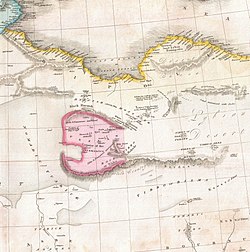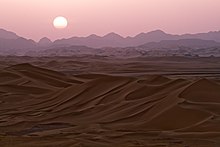Fezzan
Fezzan
ⴼⵣⵣⴰⵏ ( Arabic) | |
|---|---|
Region | |
 The Fezzan region (shown in pink), at the beginning of the 19th century | |
| Country | |
| Capital | Sabha |
Fezzan (
After the 1934 formation of Libya, the
Etymology
In Berber languages, Fezzan (or ifezzan) means "rough rocks".[5] Fezzan could also be a derivation from the region's Greek name Phasania or Phazania, which may mean "the country of the pheasants".[6]
Geography

Fezzan is crossed in the north by the ash-Shati Valley (Wadi Al Shatii) and in the west by the Wadi Irawan. These two areas, along with portions of the
History
This section needs additional citations for verification. (September 2022) |
From the 5th century BCE to the 5th century CE, Fezzan was home to the Garamantes, who operated the Trans-Saharan trade routes successively between Carthage and the Roman Empire in North Africa and Sahelian states of west and central Africa.

The Roman generals Septimus Flaccus in 19 BCE and
With the end of the Roman Empire[10] and the following commercial crisis, Fezzan began to lose importance. The population was greatly reduced due to the desertification process of the Sahara during the early Middle Ages.
During the 13th and 14th centuries, the Fezzan became a part of the
The
Beginning in 1911, Fezzan was occupied by
French administration was largely exercised through Fezzan notables of the family of Sayf Al Nasr. Disquieting to the tribes in western Fezzan was the administrative attachment of Ghat, and its surrounding area, to French-ruled Algeria.[14] However, when the French military control ceased in 1951, all of Fezzan became part of the Kingdom of Libya.[15]
Fezzan was a stronghold for Libyan leader
The LF country code (.lf) was reserved "on behalf" of Libya Fezzan (for an "indeterminate period of time") by the International Organization for Standardization (ISO).[17]
There are oil wells in Fezzan capable of 400,000 barrels per day, but oil companies fly in staff from northern Libya. The local tribes are not getting any money from the oil trade, and so have turned to smuggling migrants from other parts of Africa, which is feeding the
See also
- List of colonial heads of Fezzan
- Postage stamps and postal history of Fezzan and Ghadames
- List of French possessions and colonies
- Germa Museum
- Fezzan-Ghadames (French Administration)
- Fazzan Basin
References
- ^ a b "Fezzan". Collins English Dictionary. HarperCollins. Retrieved 26 July 2019.
- ^ "Fezzan". Lexico UK English Dictionary. Oxford University Press.[dead link]
- ^ "Fezzan". The American Heritage Dictionary of the English Language (5th ed.). HarperCollins. Retrieved 26 July 2019.
- ^ Krais, Jakob (2019). "Fazzān". Encyclopaedia of Islam (3rd ed.).
- ^ The Arabic Amazigh dictionary / 3 volumes/ published by the Academy of the Kingdom of Morocco. (Dictionnaire bilingue arabe-amazigh, tome 1 (1990), tome 2 (1996), tome 3 (1999), Publications de l'Académie marocaine.)
- ^ Présence africaine. Editions du Seuil, 1975; p. 477.
- ^ Libia. Accessed 31 August 2022.
- ^ Fezzan profile, temehu.com. Accessed 31 August 2022.
- ^ deGraft-Johnson (1954) African Glory, pg. 26
- JSTOR 1791944.
- ^ Corpus of early Arabic sources for west African history pg. 259-60
- ^ Jön Türklerin Korkulu Rüyası: Fizan denen şu yer! (tr) Archived 15 September 2012 at the Wayback Machine
- ^ Ryan, Eileen. "Italy and the Sanusiyya: Negotiating Authority in Colonial Libya, 1911-1931, academiccommons.columbia.edu. Accessed 31 August 2002.
- ^ a b Berry, LaVerle Bennette "Chapter 1 – Historical Setting -World War II and Independence – Allied Administration" Area Handbook for Libya (1987 edition) Federal Research Division, Library of Congress, Washington, D.C.; available at: A Country Study: Libya, accessed 17 May 2009.
- ^ Fezzan: French occupation, dcstamps.com. Accessed 31 August 2022.
- ^ Wedeman, Ben (20 September 2011). "Government forces enter Libya's Sabha, to cheers". CNN. Retrieved 20 September 2011.
- ^ "ISO 3166-1 Decoding Table". ISO. 2012.
LF – Libya Fezzan – indeterminately reserved
- ^ "Why the number of migrants crossing the Mediterranean is falling". The Economist. 8 September 2017. Retrieved 8 September 2017.
External links
![]() Media related to Fezzan at Wikimedia Commons
Media related to Fezzan at Wikimedia Commons
